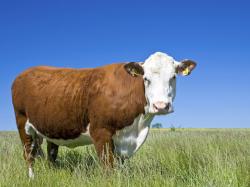Gassy Cows? Facts About Beef’s Carbon Emissions
May 21, 2018 | 2 min to read

Let’s clear the air on something up front. All those "cow farts" you’ve heard about? It’s actually cow burps. Having spent much of my life around cows and conducting research measuring methane emissions from cattle (I’m sure most readers are jealous), I can confirm the vast majority of methane emissions emanating from cattle come out the front end. Also, despite the sensory experience "gassy cows" may evoke, methane itself is an odorless gas.
Methane emissions from cattle get attention because methane is 28 times (PDF) more potent at trapping heat in the atmosphere than carbon dioxide over a 100-year time frame. Additionally, methane from cattle represents nearly half (PDF) of the carbon footprint of U.S. beef when emissions over the entire life cycle, from feed production to the consumer, are considered. However, methane also can be viewed as the necessary tradeoff for the upcycling services that cattle provide.
A key misconception about methane emissions from cattle is how the animal’s diet (PDF) can affect emissions. When cattle eat more forage, or whole plants, that contain a lot of fiber (think grass and hay), they tend to emit more methane gas. Cattle diets that include more grains, like those of most feedlot cattle in the United States, produce fewer methane emissions. In the United States, beef production is a combination of cattle spending about two-thirds of their life grazing and eating mostly forage, followed by the finishing period where cattle are typically housed in a feedlot and fed a grain-based diet (50-85 percent grain).
To read the rest of the story, please go to: Beef Checkoff
